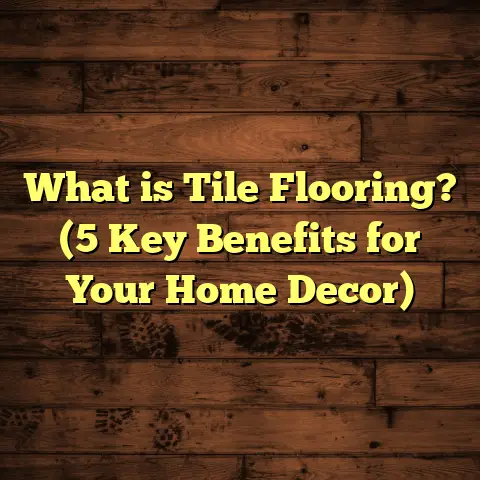What is Floor Made Out Of? (7 Materials You Didn’t Know About!)
What is a Floor Made Out Of?
When I think about floors, what stands out most is durability. A floor is something you live with daily; it’s under your feet as you cook, entertain, relax, or chase after kids and pets. Floors carry the weight of life itself—literally! They face constant pressure, spills, scratches, sunlight, and time. So, what exactly is a floor made out of? Most people immediately say “wood” or “tile,” but the reality is far more interesting. Floors come in a diverse range of materials, some of which are surprisingly strong, eco-friendly, or uniquely suited to specific needs.
Over my years in the flooring trade, I’ve encountered dozens of materials—some classic, some unusual—and learned the ins and outs of how they perform. Today, I want to share seven flooring materials you might not know much about but should definitely consider next time you think about changing your floors. Each one has its quirks, strengths, installation methods, maintenance needs, and best uses.
Ready for a journey through floors? Let’s start.
1. Bamboo Flooring: The Eco-Friendly Warrior
I remember the first time I installed bamboo flooring. A client wanted something “green” but also durable and stylish. I was impressed by bamboo’s strength and sleek look.
Bamboo is technically a grass—not wood—and it grows incredibly fast. Unlike hardwood trees that can take decades to mature, bamboo takes just 3-5 years. That rapid growth makes it one of the most sustainable flooring choices available today.
Why Choose Bamboo?
One of bamboo’s standout features is hardness. The most common type—strand-woven bamboo—is actually harder than traditional hardwoods like oak or maple. To put that into perspective, the Janka hardness test (which measures resistance to denting) rates strand-woven bamboo at around 3000 compared to 1360 for red oak and 1450 for hard maple.
This means bamboo floors resist dents from furniture or dropped objects better than many hardwoods—great if you have kids or pets.
Installation Tips
Bamboo typically comes as planks that can be installed in various ways:
- Nail-down: Similar to hardwood installation; best for wooden subfloors.
- Glue-down: Used on concrete slabs.
- Floating floors: Interlocking planks click together without glue or nails; great for DIYers.
I usually recommend floating installation in homes where moisture might be a concern because bamboo can expand or contract with humidity changes.
Maintenance Advice
Bamboo is pretty low maintenance:
- Sweep or vacuum regularly to remove grit.
- Use a damp mop (not soaking wet) with a bamboo-specific cleaner or mild soap.
- Avoid harsh chemicals or steam mops—they can damage the finish.
- Refinish every 7-10 years depending on wear.
My Bamboo Story
One project that stands out was a beach house renovation where we installed strand-woven bamboo throughout the main living areas. The owners loved how it looked modern yet natural and appreciated its resistance to sandy feet and salty air damage.
2. Cork Flooring: Soft Yet Resilient
Cork is a fantastic flooring material that many people overlook. It comes from the bark of cork oak trees harvested every 9-12 years without hurting the tree. This renewable harvesting makes cork environmentally friendly.
What makes cork special is its softness and resilience—walking on cork feels almost like walking on a cushion.
Benefits of Cork Flooring
- Comfort: Its natural cushioning reduces fatigue when standing long periods.
- Insulation: Cork has excellent thermal and sound insulation properties. I’ve noticed homes with cork floors feel warmer and quieter.
- Hypoallergenic: Cork naturally resists mold, mildew, and pests.
Installation Methods
Cork flooring usually comes as:
- Tiles: Glued down individually; perfect for irregular spaces.
- Planks: Click-lock floating floors for easy installation.
I once installed cork in a yoga studio where comfort and sound absorption were key priorities. The floating planks allowed fast installation over an uneven concrete slab.
Caring for Cork Floors
Caring for cork is simple but important:
- Sweep or vacuum often.
- Wipe spills immediately to avoid staining.
- Apply a polyurethane sealant every few years to protect against wear and moisture.
- Avoid abrasive cleaning tools that can damage the surface.
One client of mine swore by cork in her kid’s playroom because it was soft enough to cushion falls but still durable enough to handle toys being dragged across it daily.
3. Terrazzo: The Classic Comeback
Terrazzo isn’t new—it dates back to ancient times—but it’s enjoying renewed popularity in trendy homes and commercial spaces. It’s a composite material made from marble, quartz, granite chips mixed into cement or resin bases.
What makes terrazzo exceptional is its durability and artistic potential—you can create custom patterns and colors.
Why Terrazzo?
- Longevity: Terrazzo floors can last 75+ years with proper care.
- Low Maintenance: Easy to clean; just mop with neutral pH cleaners.
- Design Flexibility: Chips can be arranged in countless patterns or combined with colors.
I worked on a downtown cafe renovation where terrazzo flooring was chosen for its durability under heavy foot traffic and ability to create a unique geometric pattern matching the brand’s colors.
Installation Details
Terrazzo installation is labor-intensive:
- Pouring the base mix.
- Grinding and polishing after curing.
- Sealing the surface for stain resistance.
Because of this complexity, I always recommend hiring specialists experienced with terrazzo for best results.
Upkeep Tips
Terrazzo is near-indestructible but benefits from:
- Regular dust mopping.
- Occasional polishing for shine.
- Immediate cleanup of acidic spills (like vinegar or wine) to prevent etching.
4. Linoleum: The Vintage Vinyl Alternative
Linoleum often gets mistaken for vinyl flooring but is different. It’s made from natural materials such as linseed oil, cork dust, wood flour, and resin—making it biodegradable and eco-friendly.
It has a rich history going back to the 1860s but remains practical today.
Perks of Linoleum
- Resistant to wear and stains.
- Antibacterial qualities due to natural components.
- Wide color and pattern options.
- Comfortable underfoot with some cushioning.
I remember a client who insisted on linoleum for her kitchen because she wanted something classic yet sustainable that could handle heavy cooking activity without showing wear quickly.
Installing Linoleum
Linoleum can be purchased as:
- Sheets: Glued down over smooth subfloors.
- Tiles: Easier for DIY but may have more seams.
Proper subfloor preparation is key to avoid lumps showing through.
Maintenance Routine
Linoleum is easy to care for:
- Sweep or vacuum regularly.
- Mop with mild soap solutions.
- Avoid excessive water or harsh cleaners.
- Re-wax every few years to maintain sheen and protection.
5. Rubber Flooring: Not Just for Gyms
Rubber flooring might bring gym images to mind, but it’s increasingly used in homes for kitchens, basements, even nurseries because of its shock absorption and durability.
Why Rubber?
- Comfort: Soft underfoot reduces joint stress.
- Waterproof: Perfect for damp areas.
- Durable: Resists tearing and stains well.
I installed rubber tiles in a home gym once where the homeowner appreciated how it muffled noise and protected the concrete slab underneath from heavy weights.
Installation
Rubber flooring comes in rolls or interlocking tiles:
- Rolls are glued down; better for large areas.
- Tiles often have adhesive backing; easier replacement if damaged.
Subfloor must be clean and level for good adhesion.
Maintenance Tips
Rubber floors require:
- Regular sweeping or vacuuming.
- Damp mopping with pH-neutral cleaners.
- Avoid oils or solvents that degrade rubber over time.
6. Concrete Floors: Industrial Chic with Strength
Concrete floors bring an edgy industrial vibe that can also be sleek and modern when polished or stained.
They’re extremely durable and low maintenance but require careful finishing to be comfortable indoors.
Uses
Concrete works well in:
- Basements
- Garages
- Outdoor patios
- Modern interiors seeking minimalist style
I helped a couple polish their basement floor; after sealing, it was easy to clean and added brightness thanks to its reflective surface.
Installation Process
Concrete floors can be:
- Poured slabs during construction
- Resurfaced existing concrete with polishing/staining
Polishing involves grinding multiple times then sealing with a protective coat.
Maintenance
Simply sweep regularly and mop occasionally. Sealing every few years keeps stains at bay.
7. Recycled Glass Flooring: Eco-Friendly & Stylish
Using recycled glass in flooring is a newer trend that pairs sustainability with stunning aesthetics. Glass fragments—often from bottles or windows—are embedded into concrete or resin bases creating sparkling surfaces full of color.
Why Consider It?
It reduces landfill waste while offering unique visual appeal impossible in traditional floors.
I installed recycled glass flooring in a boutique hotel lobby; guests loved the shimmering effect under lights, and the client was proud of the eco-conscious decision.
Installation & Care
Requires skilled artisans similar to terrazzo:
- Pouring base mix
- Embedding glass pieces artistically
- Grinding/polishing for smoothness
- Sealing well against moisture
Cleaning involves gentle sweeping/mopping with neutral products only.
How To Choose The Right Flooring Material For You?
With so many options available now beyond standard hardwood or tile,
choosing the right floor means asking yourself questions like:
- How much traffic will this floor see daily?
- Are pets or kids in the home?
- What’s my budget?
- Am I looking for something easy to maintain?
- Do I want eco-friendly materials?
Thinking about these helps narrow down choices. For example,
if you want eco-friendly + durable,
bamboo or recycled glass might make sense.
If comfort + warmth matter,
cork or rubber are great bets.
If longevity + custom design are priorities,
terrazzo stands out clearly.
Personal Reflections From My Flooring Projects
Over time,
I’ve learned that floors are deeply personal choices reflecting lifestyle,
taste,
and values—not just functional surfaces underfoot.
One family I worked with chose cork because their daughter had allergies; it reduced dust accumulation so much their symptoms improved noticeably.
Another client picked terrazzo because they wanted a floor that would literally last generations without looking dated—a true heirloom piece for their home.
Data You Should Know About Flooring Materials
Here are some key stats I often share when helping clients:
| Material | Janka Hardness | Lifespan (Years) | Average Cost per Sq Ft | Sustainability Notes |
|---|---|---|---|---|
| Strand-Woven Bamboo | ~3000 | 20–30 | $5-$8 | Rapid growth; renewable |
| Cork | 90–180 | 10–30 | $3-$7 | Harvested sustainably; biodegradable |
| Terrazzo | N/A | 50–75+ | $20-$50 | Long lifespan reduces replacement waste |
| Linoleum | N/A | 20–40 | $3-$6 | Natural ingredients; biodegradable |
| Rubber | N/A | 10–25 | $4-$8 | Often recycled content |
| Concrete | N/A | 50+ | $3-$10 | Durable; uses local materials |
| Recycled Glass | N/A | 30+ | $15-$30 | Reduces landfill waste |
Maintenance Summary: Keeping Your Floor Beautiful Over Time
No matter which flooring you choose,
maintenance plays a huge role in longevity:
- Sweep/vacuum often to avoid grit scratching surfaces
- Clean spills quickly
- Use recommended cleaners only
- Avoid excessive water on wood/bamboo/cork
- Seal periodically if applicable (terrazzo/concrete/cork)
Taking these simple steps can extend your floor’s life by years or even decades.
Final Thoughts On Flooring Materials You Didn’t Know About
Floors aren’t just surfaces; they’re part of what makes a house feel like home. Knowing what materials exist beyond common hardwood or tile opens up new possibilities tailored exactly to your needs—from green bamboo forests underfoot to shimmering recycled glass masterpieces.
Whichever material you pick,
remember durability counts most since a floor that can withstand life’s chaos gracefully becomes an unsung hero in your home’s story.
If you want help figuring out which option fits your lifestyle best or tips on installation,
I’m always glad to share what I’ve learned on this journey through floors!
If you’d like me to break down specific installation guides or maintenance hacks for any material mentioned above, just ask!





